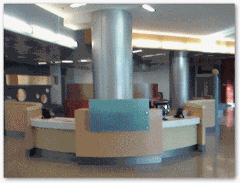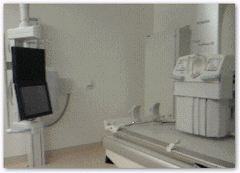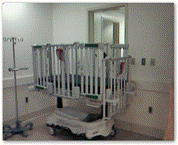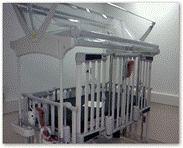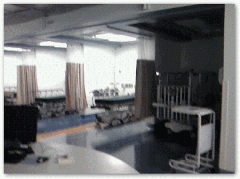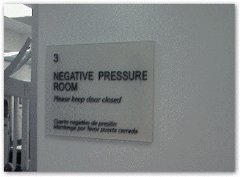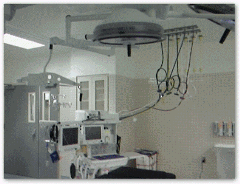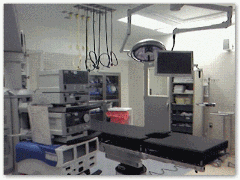Recently I had the opportunity to take a tour of Miller’s Children’s Hospital of Memorial Hospital in Long Beach California. This is the 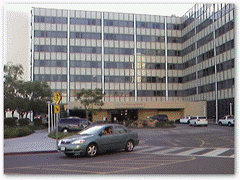 brand new facility that has taken a few years to complete and is now accepting patients. This brand new state of the art medical center is connected to Long Beach Memorial Hospital and my tour was done before the official opening.
brand new facility that has taken a few years to complete and is now accepting patients. This brand new state of the art medical center is connected to Long Beach Memorial Hospital and my tour was done before the official opening.
For my tour guide I had the pleasure of being escorted by Richard DeCarlo, chief operating officer, Miller Children’s Hospital.
The Children’s Hospital opened its new inpatient pavilion, the building consists of four stories and 124,000 square feet on December 8th, 2009. Miller Children’s Hospital is the only non-profit to receive Brownsfield Grants from the Environmental Protection Agency (EPA) for their greening efforts. All throughout the tour mentions were made about all the “green” efforts that were incorporated into the new building. For a little history, the facility once was an old oil field area and there was a lot of clean up of the soil before ground was broken. The cleaning went way deep and there was an old parking structure that was torn down before the soil efforts began, and some of the old concrete and steel was recycled for the new facility.
All throughout the facility the architecture was designed to “let the light in”, in other words you never really have the feeling of being in the “dark” as natural sunlight emits throughout. All throughout “green” and “recycle” were two words I heard quite frequently. Being that this is a children’s facility special care was taken to make sure the building had a bright and open appearance for children with decorating themes to match those which are relative to children’s environment.
The current hospital facility used was much smaller and is adjacent to the new building. You barely know you are leaving one building and walking through to the other. This is the new lobby pictured and there’s even a special baby sitting area for parents to leave children while they are visiting the one in the hospital. It’s almost hard to believe that so much of the decor consists of recycled material as it looks great.
Over 1400 pieces of art that has been created by pediatric patients will be used to decorate the new Pavilion and the day of my tour the artwork was not present yet, but nice that the children who receive care here could contribute. The linoleum floors from all natural products are also built to last and are pretty much indestructible. Each area is created with at theme of light and airy and to create a healing area for children.
One item that I noticed was the fact that almost everything is on wheels and is up off the floor. In the imaging center I saw a 320 bit CT scanner, which was selected as it delivers a lower dose of radiation, again something that went into the planning efforts to expose children to the smallest amounts of radiation possible. Richard stated the staff in imaging was totally in awe of all the space they will have to function. All imaging goes direct the PACs system, so there are less moving parts for technicians to move around and handle physically to work with.
One unique item that was built in was the ability to move expensive and high value medical diagnostic equipment into the building. As things are changing rapidly, new equipment arrives as well as moving old equipment out. The facility has a dome whereby the roof opens and a new MRI, CT Scanner, etc. can be moved in and out of the building. If you have never seen the the installation and bringing a new unit into place, this is a major project and with the opening with the dome, the job is much easier and efficient to accomplish.
The gurneys were made for children too as you can see by the pictures above and of course all the sides come down, but this way it is safer for children being moved around the hospital. The area below shows the waiting area after and before surgery. Again if you can see the floors and the bright colors in the area. Colors and designs are important, some patients end up spending quite a bit of time at the facility.
There’s a special room for children who need the extra care. Outside of this area are doors whereby parents can take a step outside to get a breath of fresh air and the area is not finished yet, but will have a nice calming effect with producing a real garden area, and this also lends itself to the “green concept” throughout the building. If one needs to make a phone call for example, it’s a nice area to be able to step out and have some privacy as well.
The hospital actually has 7 surgery rooms. In designing the rooms, lighting was a major concern and the rooms have controls that turn the rooms to give a green cast and then returns to normal daylight. Extra planning was made to have 2 doors, one for children coming in and the other for children who are leaving the surgery rooms so they don’t see each other before and after surgery. This may not seem like a big deal, but in essence it is for one child not seeing another coming directly out of surgery with all the tubes, devices, etc. connected after surgery, and I must say even as an adult it could be scary too.
Notice all the computer screens around the operating table, and there’s more behind. On a separate floor the old operating auditorium concept has been eliminated and replaced with a teaching room whereby video live streaming is used for teaching and education. The facility is also a teaching facility for UCI.
Some of the surgery rooms are quite large. Again as in other pictures you see all the new technology that is throughout the hospital. Electronic medical records from Epic are used and connected to Long Beach Memorial. All throughout the tour, there are computers available to staff everywhere.
Earlier this year I had the opportunity to discuss the transition with Dr. Leo From Long Beach Memorial hospital and you can read more here.
The patient bed areas, are made to allow parents and family to visit and designed for comfort. At each bedside is a computer, mounted on a moveable arm so the entire unit can be moved when needed. Doctors and staff do not need to go looking for a computer to input data. In addition, the facility also has “WOWs”, workstation computers on wheels that are wireless that can be used. The lighting in this area pretty much looks like natural daylight and again can be adjusted.
Richard said the lighting was an important factor to healing better and research and study went into the design as well. To me, this makes real sense too as when you think about how productive you might be on a sunny day versus a rainy day. Also you can see that everything possible seems to be built into the walls, a nice clean look and less equipment for staff to have to move around as most of what could be anticipated to be required is here.
All across the US hospitals are changing the way they operate with facilities for children and Miller’s Hospital is a shining example of all the innovation and thought processes that come into play for creating a true healing environment. Gone are all the white walls and traditional views we have all known in the past.
As technology continues to grow, so does its use in the hospital. In this post I captured some of the highlights, but there’s much more behind the scenes that contributed not only to create a successful healing environment, but one that embraces all the “green” environmental processes that go into creating a new hospital today, it’s complicated but can be done.
I want to thank Richard DeCarlo for taking a few minutes from his busy day to give me the opportunity to see what is happening with children’s hospitals today and a view of where healthcare facilities are aligned for future care. Miller’s Hospital in Long Beach is one of the largest healthcare facilities in the US, dedicated to safe and critical care for children, as we have found out over the last number of years, they have special needs and are not “small adults” just needing smaller doses or smaller treatments. Pediatric care has evolved through research and development the last few years to lead us into new and more successful methodologies for better patient care by addressing their special needs and this facility certainly speaks of making use of what is available.
Important note:
Richard also mentioned the challenges technology posed with the planning and building. They are using technologies that even as late as last year, didn’t exist, so the point made here is that during the planning and building stages, there were immediate modifications made to incorporate many of these new technologies into the blue prints as it was viewed to be technology that couldn’t wait and needed to be included in the budget and plans.

